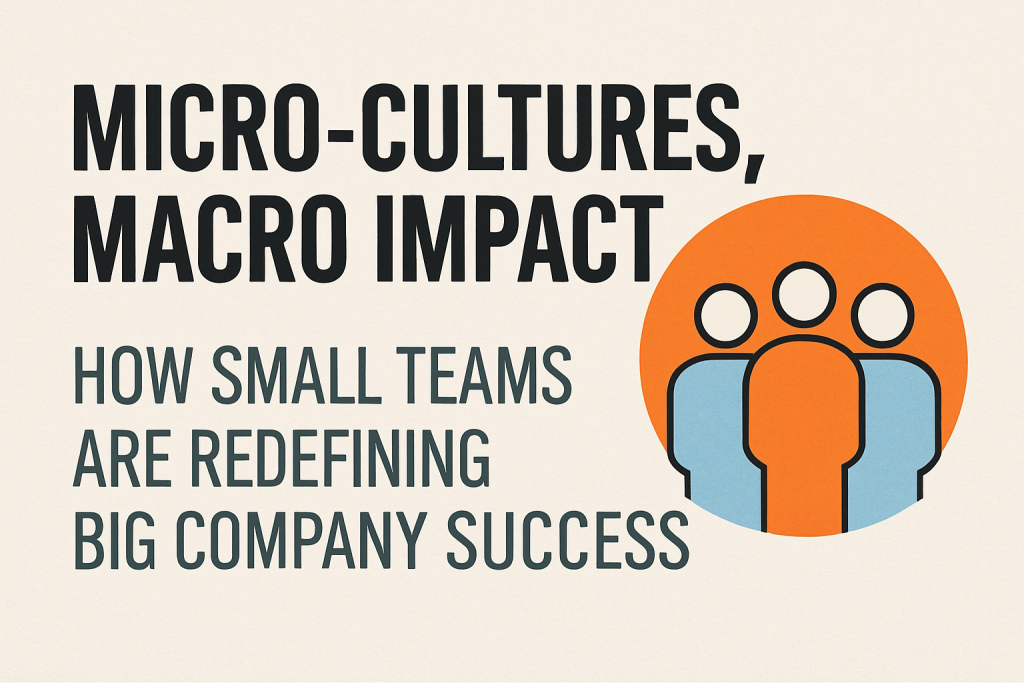These small, tightly connected teams are redefining what it means to be successful in fast-moving markets. They move faster, think tighter, innovate more creatively, and operate with a level of unity that big teams rarely match. They’re lean. They’re agile. And they’re transforming how modern organizations think about growth, culture, and performance.
In 2025 and beyond, success belongs to the companies who understand this simple truth:
Big things now happen in small rooms.
What Exactly Are Micro-Cultures?
Micro-cultures are small, self-contained subcultures within an organization—teams with their own shared values, rituals, language, pace, and identity. They operate like mini start-ups inside the larger company ecosystem.
Unlike traditional departments, micro-cultures are built on:
These teams typically range from 3–12 people, creating an environment where collaboration is natural, communication is fluid, and accountability is shared—not forced.
Think of them as highly specialized units that operate with clarity, cohesion, and chemistry.
Why Micro-Cultures Are Taking Over Modern Business
1. Speed Is the New Competitive Edge
Large teams move slower—more approvals, more confusion, more decision layers.
Micro-cultures cut through the noise.
With fewer people, decisions are made faster, ideas are executed quicker, and feedback loops tighten. The modern customer doesn’t reward companies for being perfect—they reward companies for being first, responsive, and adaptive.
Micro-cultures give organizations the ability to:
Speed isn’t just an asset anymore—it’s survival.
2. Productivity Skyrockets When Teams Stay Small
Small teams naturally operate with:
Instead of spending hours in meetings, micro-cultures focus on doing.
Their work dynamic mirrors elite special operations teams:
Everyone knows their role
Everyone knows the mission
Everyone trusts each other
Everyone pulls their weight
In these environments, people don’t wait to be told what to do—they move.
3. Micro-Cultures Strengthen Connection and Belonging
Large companies often struggle to make employees feel seen or heard.
Micro-cultures solve this.
Inside these small teams, people build real relationships. They share wins, failures, ideas, and challenges. They trust each other. They feel valued.
Connection fuels:
When people feel like they belong, they create at a higher level—and stay longer.
4. Innovation Thrives in Small Environments
Large groups tend to default to groupthink. Micro-cultures, on the other hand, nurture creativity.
Smaller teams think differently because they:
Collaborate more intimately
Experiment more freely
Feel safer sharing bold ideas
Iterate faster
Test new solutions without layers of resistance
Innovation is no longer a corporate department—it’s a culture inside every small team.
5. Micro-Cultures Create Leaders, Not Employees
Big organizations can unintentionally breed dependency—waiting for permission, waiting for direction, waiting for clarity.
Micro-cultures breed leadership.
Team members:
Think like owners
Take initiative
Solve problems proactively
Carry shared responsibility
Build confidence through autonomy
Instead of one central leader, micro-cultures develop many leaders—and leadership is now a distributed skill, not a job title.
6. Accountability Becomes Natural, Not Forced
When your team is small, you can’t hide.
Everyone’s contributions (or lack of) are visible. This transparency fuels self-regulation instead of micromanagement.
In micro-cultures:
Accountability becomes a cultural habit, not a corporate policy.
How Small Teams Are Transforming Big Companies
Across industries—from tech and marketing to healthcare and manufacturing—small elite teams are shaping the future of organizational success.
Here’s how:
1. They Create Ground-Level Insight That Leadership Can’t See
Executive teams see strategy.
Micro-cultures see reality.
They’re closest to the customer, the market, the friction points, and the opportunities. Their insights are more accurate, more relevant, and more up-to-date.
This gives leadership a real-time pulse on what matters.
2. They Reduce Organizational Waste
Because small teams operate lean, they:
Skip unnecessary meetings
Avoid redundant approvals
Reduce communication gaps
Eliminate bloated workflows
Increase clarity across projects
What used to take weeks now takes days—or hours.
3. They Increase Company-Wide Culture Strength
Micro-cultures don’t replace organizational culture—they amplify it.
When each team develops strong internal chemistry, the entire company benefits from:
A strong culture isn’t built at the top—it’s built in small rooms carried by committed people.
4. They Attract Better Talent
Top performers don’t want to be another cog in a corporate machine.
They want:
Purpose
Autonomy
Ownership
Creativity
Impact
Micro-cultures give them exactly that.
This attracts high-caliber talent who prefer real influence over corporate hierarchy.
5. They Create Organizational Agility
The future belongs to companies that can adapt.
Micro-cultures give organizations the ability to:
They turn big companies into flexible, adaptive ecosystems.
How to Build Micro-Cultures Inside Your Organization
You can’t force a micro-culture into existence—but you can build the environment where one thrives.
Here’s the blueprint:
1. Start With Purpose
Every micro-culture needs a mission.
Not corporate jargon.
Not a slogan.
A clear, shared purpose that everyone believes in.
Questions to define it:
Why does this team exist?
What problem are we solving?
What unique impact do we want to have?
What principles guide our decisions?
Purpose is the glue that keeps a micro-culture aligned.
2. Recruit for Chemistry, Not Just Competency
Skills matter.
But compatibility matters more.
Choose people who:
A micro-culture is only as strong as the relationships inside it.
3. Empower Autonomy
Give small teams the freedom to:
Micro-cultures thrive when they’re trusted—not controlled.
4. Eliminate Bureaucracy
Nothing kills a micro-culture faster than:
Endless approvals
Slow processes
Rigid hierarchy
Micromanagement
Red tape
Simplify systems.
Shorten workflows.
Give ownership.
5. Encourage Rituals and Identity
Micro-cultures thrive when they feel like a team.
Encourage:
These rituals shape the identity and rhythm of the group.
6. Protect Psychological Safety
Innovation requires vulnerability.
Teams must feel safe to:
Psychological safety builds trust—and trust builds speed.
7. Measure Output, Not Activity
Micro-cultures should be judged by:
Outcomes
Progress
Creativity
Quality
Impact
Not hours, emails, or “busyness.”
This encourages high-performance autonomy—not pressure.
Real-World Examples of Micro-Culture Wins
Tech Startups
Companies like Figma, Slack, and Notion started with micro-teams who built category-defining products before hiring at scale.
Marketing Agencies
Agencies running pod-based structures outperform traditional layered models, delivering faster results and higher client satisfaction.
Fortune 500 Transformation Teams
Even giants like Google, Amazon, and Meta rely on micro-teams for innovation, experimentation, and rapid deployment.
Creative Teams
Film crews, design studios, and product development squads operate as micro-cultures—small, tight-knit, high-output teams with shared missions.
These companies succeed not in spite of small teams—but because of them.
Why Micro-Cultures Are the Future of Work
The workforce is changing.
Employees want:
Meaning
Autonomy
Impact
Community
Flexibility
Growth
And businesses want:
Speed
Innovation
Efficiency
Adaptability
Accountability
High performance
Micro-cultures deliver both.
They bridge the gap between organizational goals and human needs.
They create the perfect environment for peak performance.
And they redefine what it means to build a company where people love to work—and where innovation happens naturally.
Final Thoughts: Big Success Starts Small
The organizations winning in the modern economy don’t just scale teams—they scale impact.
And impact is built in small rooms, by small teams, with big purpose.
Micro-cultures aren’t a trend.
They’re a shift in how high-performing companies operate.
If you want:
Better culture
Faster execution
Stronger innovation
Lower turnover
Higher performance
Happier teams
…start small.
Build teams with chemistry.
Give them purpose.
Let them lead.
Protect their autonomy.
And watch how fast the entire organization transforms.
Because the truth is simple:
Small teams create big results. Micro-cultures create macro impact.










